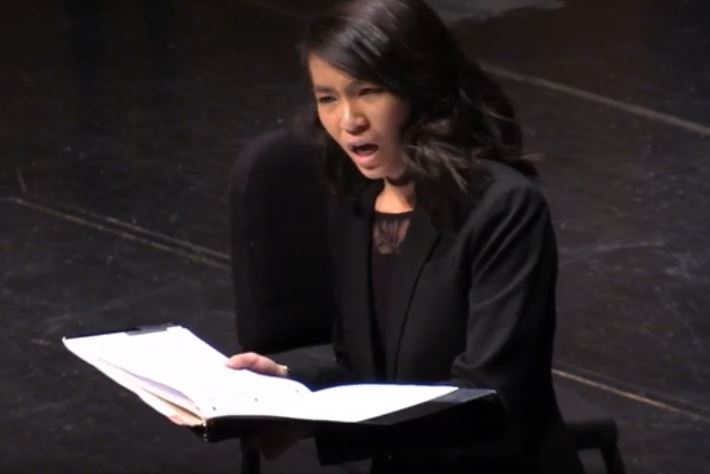Choral Review
UC Davis, Department of Music
University Chorus and Chamber Singers - December 6, 2019
It’s always a pleasure to attend a concert in Mondavi Center’s Jackson Hall. But I was especially looking forward to this performance because it would be my first opportunity to hear UCD’s University Chorus under the direction of Caleb Lewis since he started as UCD’s Director of Choirs last year. This would also be my first time to hear the University Chorus without the University Orchestra ― and my first time to hear their Chamber Singers. There were other firsts for me. As I sat waiting for the concert to begin, I reviewed the program and noted that well over half the selections were pieces I’d never heard before ― a special treat for someone who’s attended very many choral concerts.
Minutes before the start of tonight’s program, a brass octet assembled in a semicircle well downstage, and it was clear that we were going to experience a rousing performance of Rutter’s Gloria. Presently the University chorus filed in ― 38 women and 12 men ― each one dressed in some completely black outfit. Conductor Caleb Lewis then entered the stage to a warm welcome from the audience.
(Click here to open the program in a new window.)
After a brief acknowledgment of the applause, Lewis began directing
the dramatic instrumental beginning of the first movement of Rutter’s
Gloria. Although somewhat overpowered by the brass (and timpani) in
front of them, it seemed to me that the chorus embraced the passion of
this first movement. There’s no question that we in the audience felt
the excitement of this “Allegro vivace.”
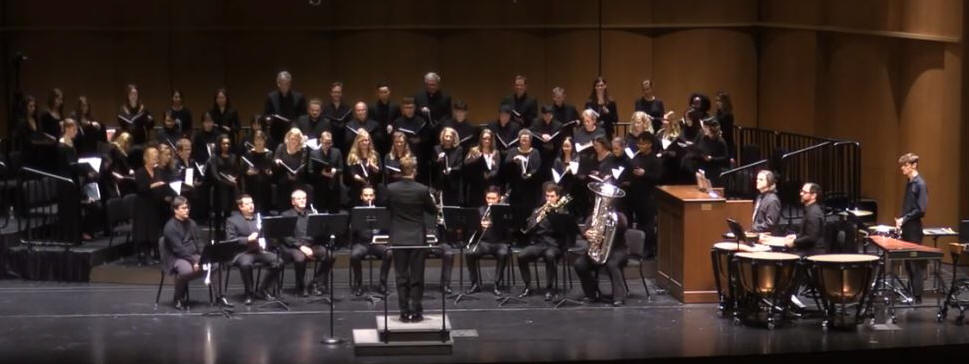
It seems that I’ve heard the first movement of the Gloria many times. Somehow though, I don’t recall the subsequent movements, so it was a treat to hear them this evening. The second movement, “Andante,” was full of delicious dissonances and more restrained singing. I’ve often felt that the test of a chorus is how well they sing softly and how well they can control a diminuendo that slowly disappears into nothing. There were many times this evening when the University Chorus (and Chamber Singers) excelled in this way. In the second movement, this restrained singing made the principal crescendo ― thrilling and artful ― that much more effective before they proceeded to a beautifully balanced progression of chords and a final diminuendo.
The third movement, “Vivace e ritmico,” was a return to high energy, with challenging runs for the chorus taken at what seemed to me an impossibly fast tempo. It felt like watching scenery race by from the passenger window of a speeding car, and it was an interesting, engaging journey. For a few minutes at the beginning of the concert, I thought this venue might be too large for the unamplified chorus. By the end of the Gloria, however, I had completely changed my mind.
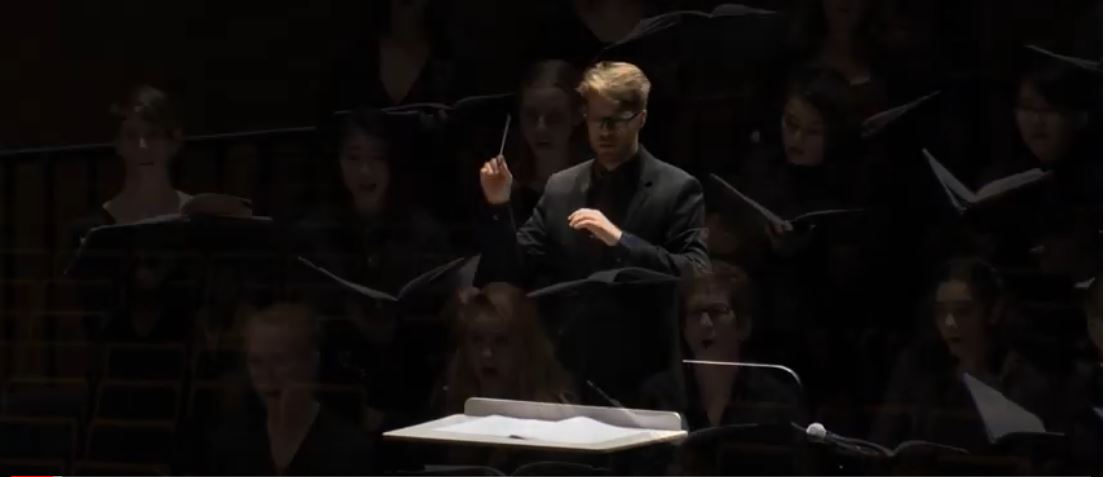
Between these two settings of what one might call the Orthodox “Ave Maria” were two settings of the Catholic “Ave Maria.” These were performed by the Chamber Singers, a 15-member SSAA choir that entered just before the first of these pieces, forming a large semicircle downstage in front of the University Chorus. The first “Ave Maria” was by Saint-Saëns with organ accompaniment. The second was by Monteverdi and performed a cappella. Apart from the quality singing that I was hearing, I felt that the presentation was reverential. And it was interesting to consider again two settings of the same text, composed in such different musical styles (early Baroque vs. Romantic) and from composers who lived nearly three centuries apart.
Before the second “Bogoroditse Devo” came the “Magnificat” from
The Nativity According to Saint Luke by American composer Randall
Thompson (and arranged by David A. Seitz). This was performed by the
Chamber Singers with organ accompaniment, and it seemed to me that they
embraced this piece more completely than the Ave Marias they had just
performed. Perhaps it gave them greater latitude for expressiveness. In
any case, I felt it was a good vehicle for a treble choir. I have to add
that the soloist’s performance was a highlight for me with her rich,
expressive soprano voice and precise pitch. It would have been nice to
see her credited in the program.
It wasn’t until after the last of these 5 pieces honoring the Virgin Mary that the audience applauded. It had felt strange to me that there was no applause after the first of them, and it was only later that I recognized that they constituted an integrated segment of the program. Somehow the rest of the audience seemed to understand this. Still, I think it would have been helpful to have had an announcement from Lewis or a note in the program about holding applause until after the last of these 5 pieces.
That brings up one of the most interesting features of this concert ― the programming. As my comments below will emphasize, there was great variety in the music presented this evening ― different periods, languages, styles, ensembles, etc. At the same time there was food for thought and I dare say an educational purpose in the selections and their proximity to each other.
It’s an enormous leap from Rachmaninoff to James McKelvy’s “Deck the Hall (in 7/8).” That “7/8” is the time signature of this arrangement, and the chorus performed it with high energy and a crisp, rigorous delivery of the challenging rhythms. Moreover, it was new to me and fun listening, so I’ve gone to YouTube to try to hear the piece again. Sadly, none of the recordings I viewed came near to matching the energy and tempo with which the piece was delivered by the University Chorus on this evening.
“Ding a Ding a Ding” was performed a cappella by the Chamber Singers. To me, it was a lilting piece with a complexity introduced by difficult overlapping vocal lines. The choir mastered the challenges, giving a satisfying performance, and once again I was impressed with some excellent soft singing.
With composer Susan Powell at the piano, “Winter Eyes” was, for me, a highlight of this concert. It was also a premiere performance of her piece, which was a beautiful celebration of the season, full of evocative musical and verbal images. I was glad that there was enough light in the hall that I could follow Douglas Florian’s lyrics in my program in the semi-darkness. The music itself had fanciful moments, but it was mostly full of lush chords and an interesting interplay of the vocal parts. From the audience’s perspective, it was delightful, interesting listening, and I imagine it must have been very satisfying for the chorus to perform.
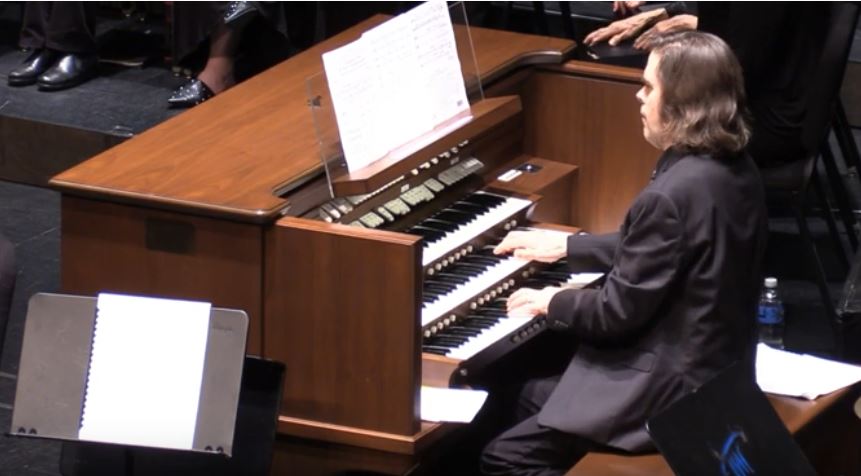 |
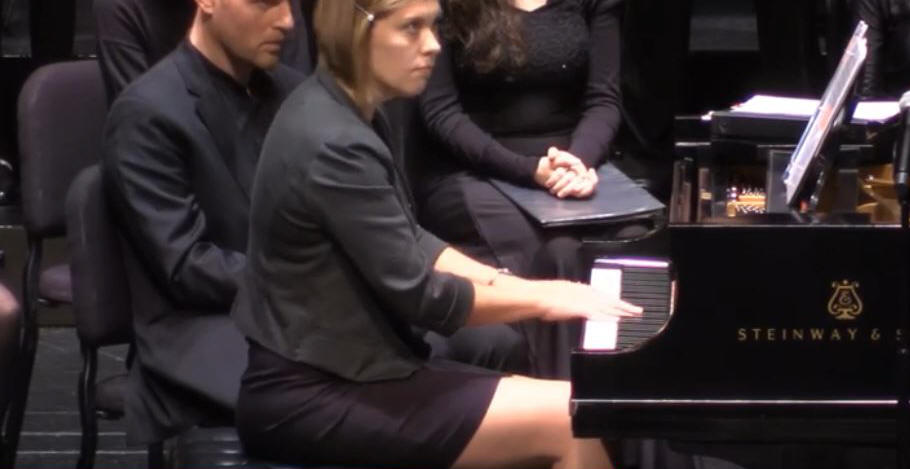 |
| Jeffrey Jubenville | Susan Powell |
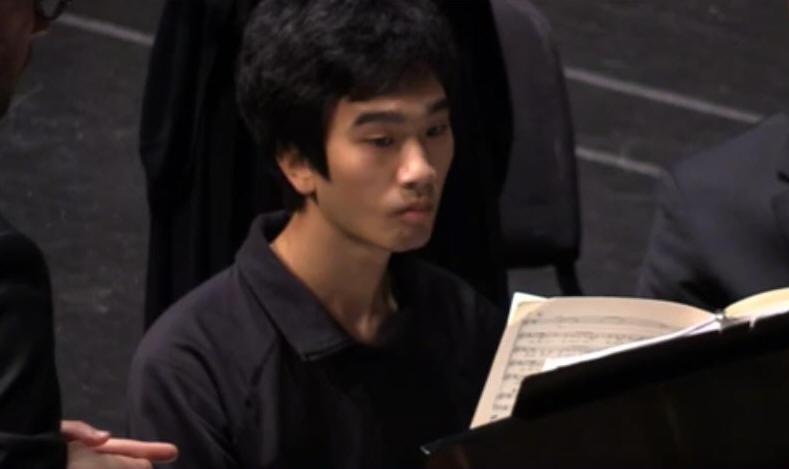 |
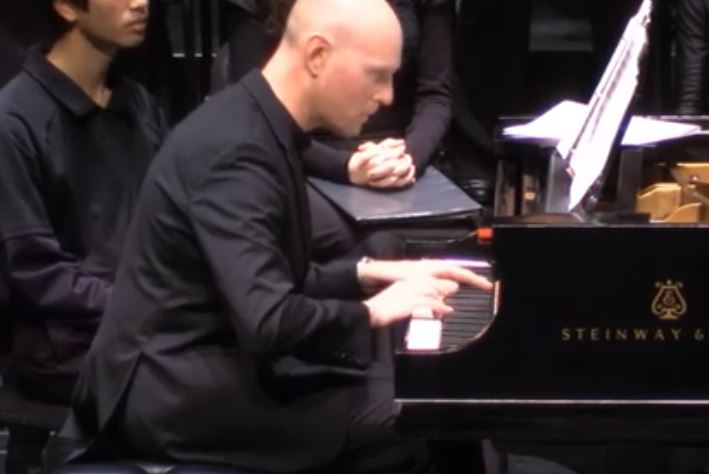 |
| William Eng | Daniel Godsil |
I’ll confess I had difficulty warming to Laura Hawley’s “Carol Trilogy.” However, I can understand the intellectual appeal of the music or the satisfaction of mastering its technical challenges. The highlight of this performance for me was the brilliant piano work by William Eng. But judge for yourself: visit her publisher’s page here and listen to a recording and see what they say about it.
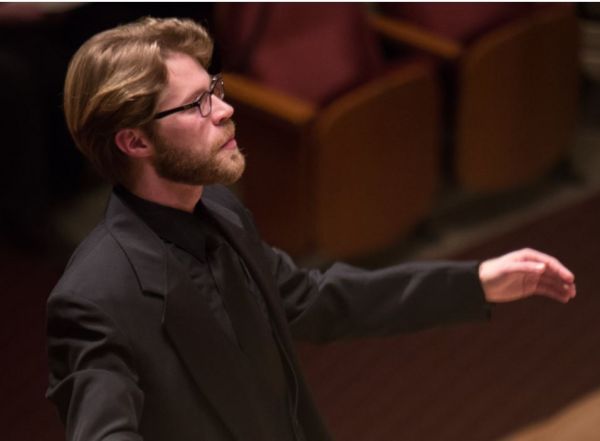
I said earlier that this was a concert with very diverse elements, and it reflects the wide interests of Conductor Caleb Lewis. My guess is that he’s still not well known among the choral community in the Sacramento region. Take a look at his resume in his website, and you’ll see extensive choral directing experience (including university, church and professional choruses), vocal performance (including with the American Bach Soloists and numerous solo engagements), and ABD (“all but dissertation”) in his doctoral work in choral conducting and vocal performance at Indiana University. He’s even bilingual and has conducted Spanish choirs. You get an idea of the breadth of his interests from this wording in his website: “He often enjoys singing early music, pop, gospel, Byzantine chant, as well as more traditional classical repertoire.”
With all that, there’s no surprise that his Chamber Choir next brought the house down with “Go Where I Send Thee!” It was a rocking arrangement, full of syncopation, and I can’t imagine how the audience was able to resist clapping along with the music. For all its fun, it was sophisticated music ― 3 arrangements in one, as it seemed to me ― and the singers really embraced the spirit, eventually slapping their thighs as they held their music in the other hand, and ending with a foot-stomp.
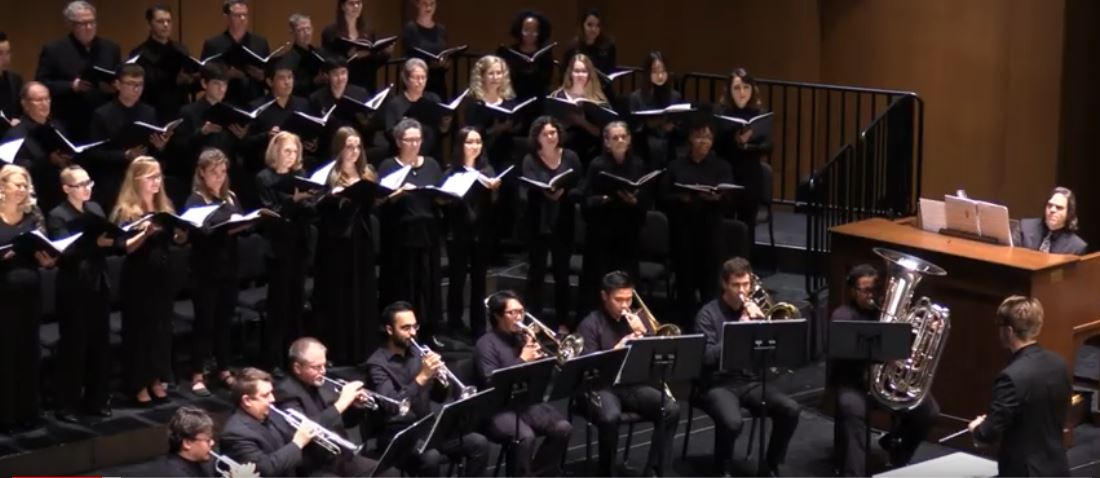 |
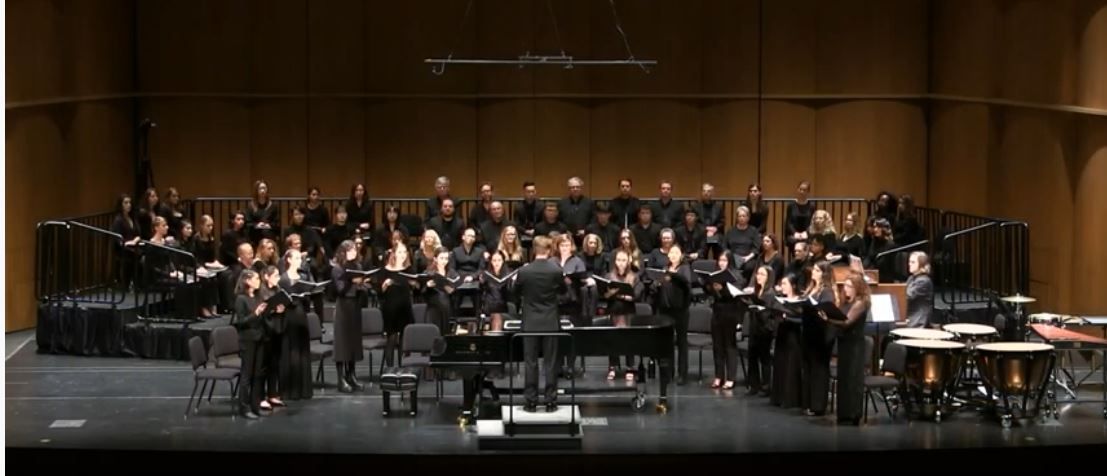 |
| Brass Octet in Gloria | Chamber Singers (in front semicircle) |
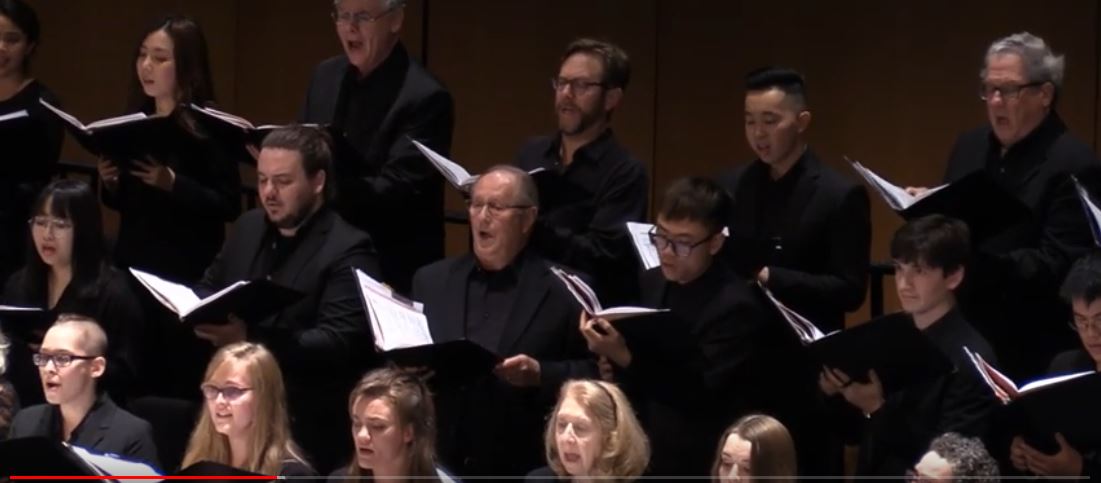 |
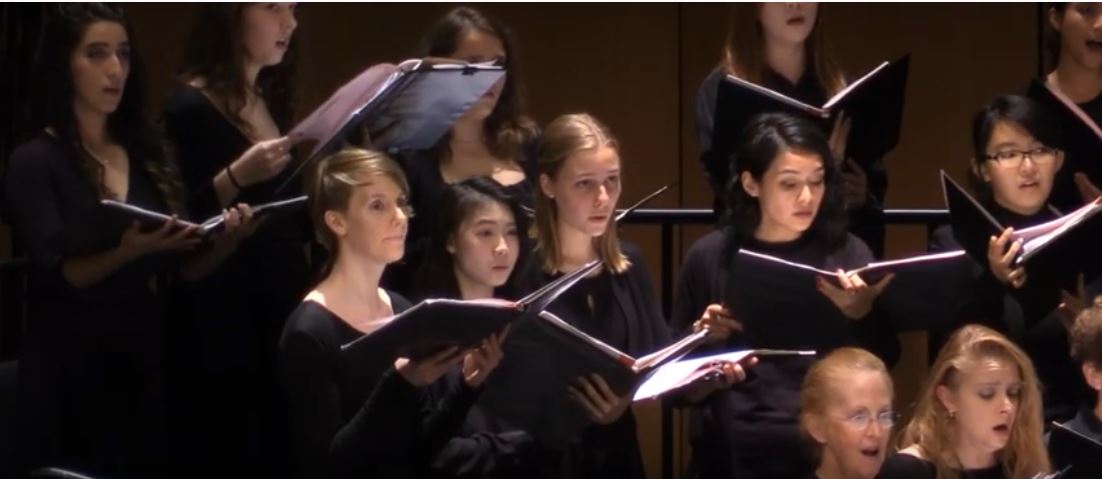 |
| University Chorus | University Chorus |
For the final selection, Mack Wilberg’s “Ding Dong! Merrily on High,” both choruses joined for a performance that was just bursting with joy, even exultation. At its conclusion, the audience erupted with applause and cheers. I bet many of them left humming the melody of that last song (as I did). It was the perfect conclusion of a concert that no doubt kept all of us cheerful and energized as we went out into a cold, rainy night.
Note: Surprisingly, a video of the entire 70-minute concert was posted on YouTube during the day after the concert. You can find it at this link: https://youtu.be/gl5LQvlugXc. It was a remarkable job of videography, and nearly all the pictures on this page were extracted from the video. However, there was a problem with the sound being virtually inaudible until about the 1:03:00 point. Hopefully, the sound will be fixed in the coming days. If not, you can still enjoy "Go Where I Send Thee!" starting at about the 1:03:40 point, followed by "Ding Dong Merrily on High.")
Dick Frantzreb is editor of the Capital Region Performance Gallery. He also edits the Sacramento Choral Calendar and the Placer Performance Calendar, and he was a co-founder and past President of the Sacramento Valley Choral Coalition. He has been loving live performances in the greater Sacramento area and writing about them since 2012.
